- ΝΕΑ /
- Από εδώ έως την αιωνιότητα
Από εδώ έως την αιωνιότητα
Ιούλιος 2024

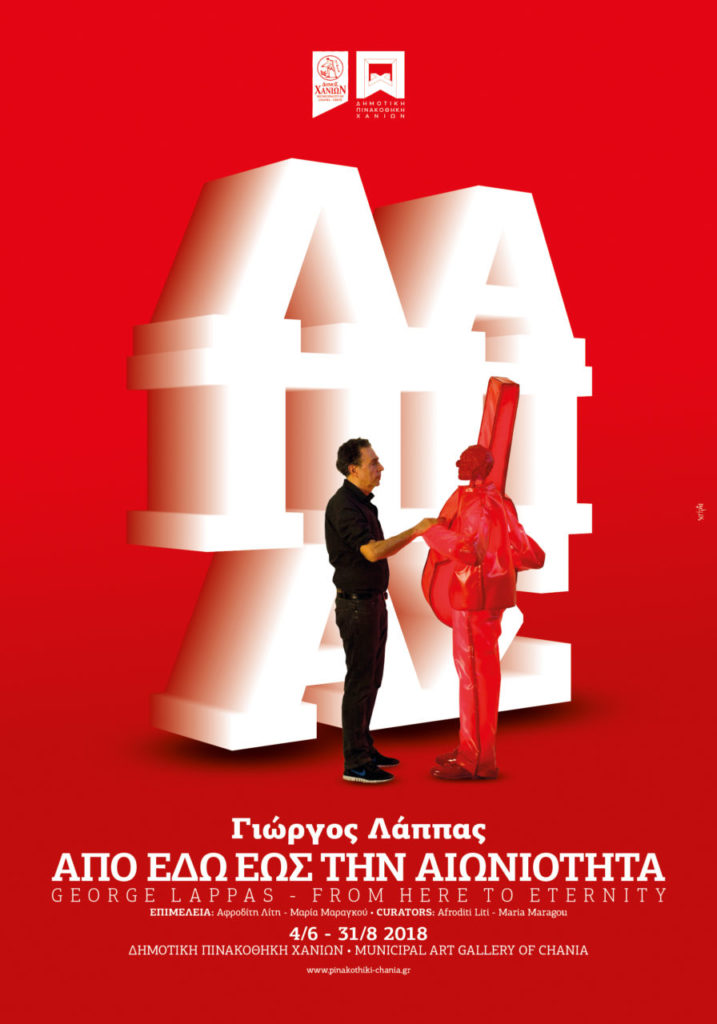
Η Δημοτική Πινακοθήκη Χανίων διοργανώνει την έκθεση με τίτλο “Από εδώ έως την αιωνιότητα”, επιμέλεια: Αφροδίτη Λίτη – Μαρία Μαραγκού.
Τα εγκαίνια της έκθεσης θα πραγματοποιηθούν τη Δευτέρα, 4 Ιουνίου 2018, στις 20.30 μμ και η έκθεση θα διαρκέσει έως και την Παρασκεύη, 31 Αυγούστου 2018.
Ωράριο λειτουργίας: Δευτέρα έως Σάββατο, 10.00 – 14.00 και 19.00 – 22.00
Φιγούρες και σακίδιο με αυτιά
Απόσπασμα από το συνοδευτικό κείμενο της έκθεσης
Φιγούρες και Σακίδιο με Αυτιά, Γκαλερί Citronne, Πόρος, 2017
Mια μικρή μακρόστενη βιτρίνα, αναρτημένη στον τοίχο, γεμάτη tricks, πάνω στην οδό Ακαδημίας, απέναντι από την εκκλησία της Ζωοδόχου Πηγής, μου κρατούσε άσβεστη τη φλόγα της φαντασίας μου για χρόνια, επί καθημερινής βάσης, πηγαίνοντας και γυρνώντας από το σχολείο.
Χρωματιστά, μικρά, ευτελή, ανόμοια αντικείμενα ίσα που να χωρούν σε μια λεπτή επίπεδη γυάλινη επιφάνεια εμπεριείχε σοφία αιώνων και κόσμους ολόκληρους από την ταχυδακτυλουργία, τη γλυπτική και την ψυχαγωγία.
Στο άνοιγμα της ψηλής πόρτας της εισόδου του κτηρίου, πάντα στα δεξιά, ήταν καθισμένος ένας επιβλητικός, ευγενής, σιωπηλός κύριος, με βαθύ βλέμμα, φορώντας ημίψηλο μαύρο καπέλο.
Αυτή ήταν ολόκληρη η επιχείρηση, από τα τέλη του ’60 και όλη την δεκαετία του ’70 και τις αρχές του ’80.
Με τον Γιώργη συναντηθήκαμε στη Σχολή το ’77 και μας ένωσε το μεγάλο πάθος μας για το σχέδιο πάνω στο μοντέλο. Οι άνθρωποι αυτοί για μας ήταν η οικογένειά μας, μέσα από αυτούς εισερχόμασταν στα βαθιά νερά της δουλειάς μας που σήμαινε τη γνώση του ανθρώπου και της ιστορίας του.
Μεταξύ αυτών ο Γιώργης ξεχώρισε τον Σόλωνα ο οποίος ήταν αριστοκράτης Αιγυπτιώτης και τον εύσωμο κύριο Γιώργο.
Ο Σόλωνας στα διαλείμματα της πόζας συνήθιζε να βγάζει το πάνω μέρος των ρούχων του και να στέκεται όρθιος, με τα χέρια στη μέση, προκειμένου να λιαστεί στους διαδρόμους της Σχολής, στο Πολυτεχνείο. “Ίσως να του έλειπε ο πολύς ήλιος της Αιγύπτου!”
Ο κύριος Γιώργος ήταν ψηλός και ευτραφής, οι κινήσεις του όμως δεν είχαν σχέση με την εικόνα του, ήταν ευλύγιστος και αέρινος, θα έλεγε κάποιος ότι μπορεί να ήταν και χορευτής, ακόμα και ισορροπιστής, αφού μέσω των κινήσεών του μπορούσε να εξαφανίσει τον όγκο του.
Οι σπουδές πάνω στο σχέδιο και τον πηλό του Γιώργη με είχαν εντυπωσιάσει, κυρίως ο τρόπος που έψαχνε πίσω από τους ανθρώπους.
Κάποια στιγμή έχοντας σταχυολογήσει όλους αυτούς τους παράγοντες αποφάσισα να γνωρίσω στον Γιώργη το κρησφύγετό μου στην Ακαδημίας.
Μετά από αλλεπάλληλες επισκέψεις, ο Γιώργης κατάφερε να μαγέψει τον κύριο με το ημίψηλο, ο οποίος όπως αποδείχθηκε ήταν επαγγελματίας μάγος και ταχυδακτυλουργός. Έτσι ξεκίνησαν οι μελέτες του, μέσα σ’ αυτήν την είσοδο, κατόπιν διακανονισμού του χρόνου της πόζας και της επίδειξης των τεχνασμάτων. Εκεί θυμάμαι να ξεπετάγονται από παντού πουλιά, λαγοί, αυγά, τράπουλες, μαντήλια και ό,τι μπορούσε να βάλει ο νους μας, αλλά συγχρόνως και να εξαφανίζονται ως διά μαγείας, ώστε να μένει σ’ αυτή την απέριττη είσοδο η απλή ξύλινη πολυθρόνα και ο μάγος με το όνομα Κρις.
Ήταν όμορφος με δέρμα αλαβάστρινο, λευκό, χωρίς ρυτίδες, δεδομένου ότι δεν έκανε μορφασμούς, δεν εκδήλωνε κανένα συναίσθημα και χρησιμοποιούσε το βλέμμα του για να σε καθυποτάξει. Το μεγαλείο της τέχνης του βρισκόταν εκεί, κάτω από το μπορ του ημίψηλου, στα μάτια του. Θεωρώ ότι ο Κρις ολόκληρος ήταν ένα μέρος της πολιτιστικής μας κληρονομιάς.
Οι τρεις αυτοί άνθρωποι είχαν κοινά χαρακτηριστικά, ήταν μορφωμένοι, μιλούσαν ξένες γλώσσες και είχαν ταξιδέψει πολύ στη ζωή τους, κατορθώνοντας να μεταφέρουν όλα αυτά τα στοιχεία στον τρόπο στάσης της ζωής τους.
Μετά τη Σχολή ο Γιώργης συνεργάστηκε με τον Σόλωνα και τον κ. Γιώργο για τις μελέτες του στο εργαστήριο, ενώ με τον Κρις δούλευε στον ίδιο ακριβώς χώρο μέχρι το κλείσιμο της επιχείρησης.
Συνεχίζοντας τη δουλειά του πάνω στη φιγούρα σε ορισμένους τύπους των έργων του, αντικατέστησε τα μοντέλα με την δική του μορφή, κυρίως στους ακροβάτες και τους ισορροπιστές.
Επισκεπτόμενη πριν από ένα χρόνο το χυτήριο εντόπισα έναν αριθμό έργων που τελευταία προσπάθησε ο Γιώργης να μεταφέρει σε υλικό, επρόκειτο για μια ενότητα την οποία δούλευε σε όλη την πορεία της δουλειάς του.
Ήταν φιγούρες από τον Σόλωνα, τον Κρις και τον κ. Γιώργο καθώς και το σακίδιο με τα αυτιά […]
Αφροδίτη Λίτη
Γλύπτρια, Καθηγήτρια Γλυπτικής στην ΑΣΚΤ
Από εδώ έως την αιωνιότητα
Το σπίτι, ο μικρόκοσμος, το ταξίδι, το τυχαίο, το μοιραίο, τα πρόσωπα, η ζωή…
Πίσω στις αρχές της δεκαετίας 1980 στο υπόγειο της γκαλερί Ζουμπουλάκη στην πλατεία Κολωνακίου, ένας νέος γλύπτης απλώνει τον μικρόκοσμο του, στο δάπεδο. Πρώτα το έργο «Άβακας» (1983) και αργότερα (1987) το έργο «Mappemonde». Συγκλονίζομαι, δίχως καλά καλά, να μπορώ να εξηγήσω με επιχειρηματολογία, τους λόγους και τα αίτια. Η γοητεία που μας ασκεί ένα έργο με την πρώτη ματιά είναι ο πλέον ευκρινής και αδιάψευστος κριτής. Στην συνέχεια, προχωρεί η σκέψη για να τοποθετηθεί το πλήθος των γλυπτών του συγκεκριμένου έργου, η σχέση τους με την προσωπική γεωγραφία ή βιογραφία του καλλιτέχνη, η έρευνά του στο χώρο με αυτή την έξοχη παρατακτική γεωμετρία των μορφών.
Είναι μια κουβέντα αυτή που, θα κάνουμε πολλές φορές, από τότε, με τον Γιώργο Λάππα, όπως, για ποιο λόγο μας συνεπαίρνει ένα έργο τέχνης, εξ’ αρχής, πως απεγκλωβίζεται η ενέργεια, γιατί το μέτρο της ωριμότητας του καλλιτέχνη έχει να κάνει με την αλήθεια του έργου του, πως δημιουργείται η αλχημεία βάση των συστατικών που, μπορεί και να μην ελέγχεις.
Ας ξεκινήσω, ωστόσο, με μια τοποθέτηση που, μας αφορά όλους και έχει να κάνει με το αδυσώπητο τοπίο του χρόνου αλλά και του τόπου, σε σχέση με την δουλειά του Λάππα.
Ξεκινά από εδώ, από τον τόπο, και είναι η καλή συνέχεια του Γιαννούλη Χαλεπά, του Γεράσιμου Σκλάβου και του Τάκι. Ως σημασία, δηλαδή ως ποιότητα και ευρηματικότητα δίχως τέχνασμα, ως βαρύτητα, του όρου που ονομάζουμε νεώτερη ελληνική γλυπτική, αλλά και ως ευρύτερη, εκτός τοπικών συνόρων δυναμική που ανοίγει δρόμους. Ο ίδιος ο Λάππας, λάτρεψε τον Χαλεπά, τον παρακολούθησε και τον δίδαξε στην Σχολή Καλών Τεχνών, όπως εξ΄ άλλου και τον Τάκι. Ο πηλός, του φτωχού βοσκού από την Τήνο και τα άπειρα πήλινα εκμαγεία του δικού μας καλλιτέχνη, ίσως και να ‘χουν μία επιπλέον σχέση μυστικής συγγένειας.
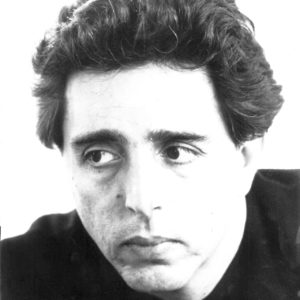
Ο Γιώργος Λάππας, μοιάζει να έρχεται από παντού και όχι μόνο επειδή υπήρξε από μικρό παιδί ταξιδευτής, από την Αίγυπτο στη Θεσσαλονίκη, μετά στην Αθήνα, στη συνέχεια στις ΗΠΑ και στο κόσμο και, να αντέχει οπουδήποτε, με ισχυρές αποσκευές τις εικόνες των αιγυπτιακών γλυπτών τόσο συνδεδεμένες με τα κεφάλια των ζώων και το αίσθημα «του ντελίριου και της δικαιοσύνης» που ένοιωσε παιδί με την τέχνη του Σωτήρη Σπαθάρη.
Οι σχεδόν τρείς χιλιάδες φιγούρες του «Mappemonde» του 1980 τα πολυπρόσωπα δηλαδή στοιχεία που κάνουν ένα κόσμο τεράστιο και πλήρη με τις αλληλεξαρτήσεις, τις αλληλοσυμπληρώσεις και τις μεταξύ τους σχέσεις στο χώρο που καταλαμβάνουν, δημιουργούν ένα κόσμο με συνέχειες, κοινωνικά και ιστορικά συμβάντα, αλληλένδετα και ορίζουν μια τέχνη που, σαφώς δεν είναι η γλυπτική της μορφής αλλά η γλυπτική του πλήθους και των εννοιών.
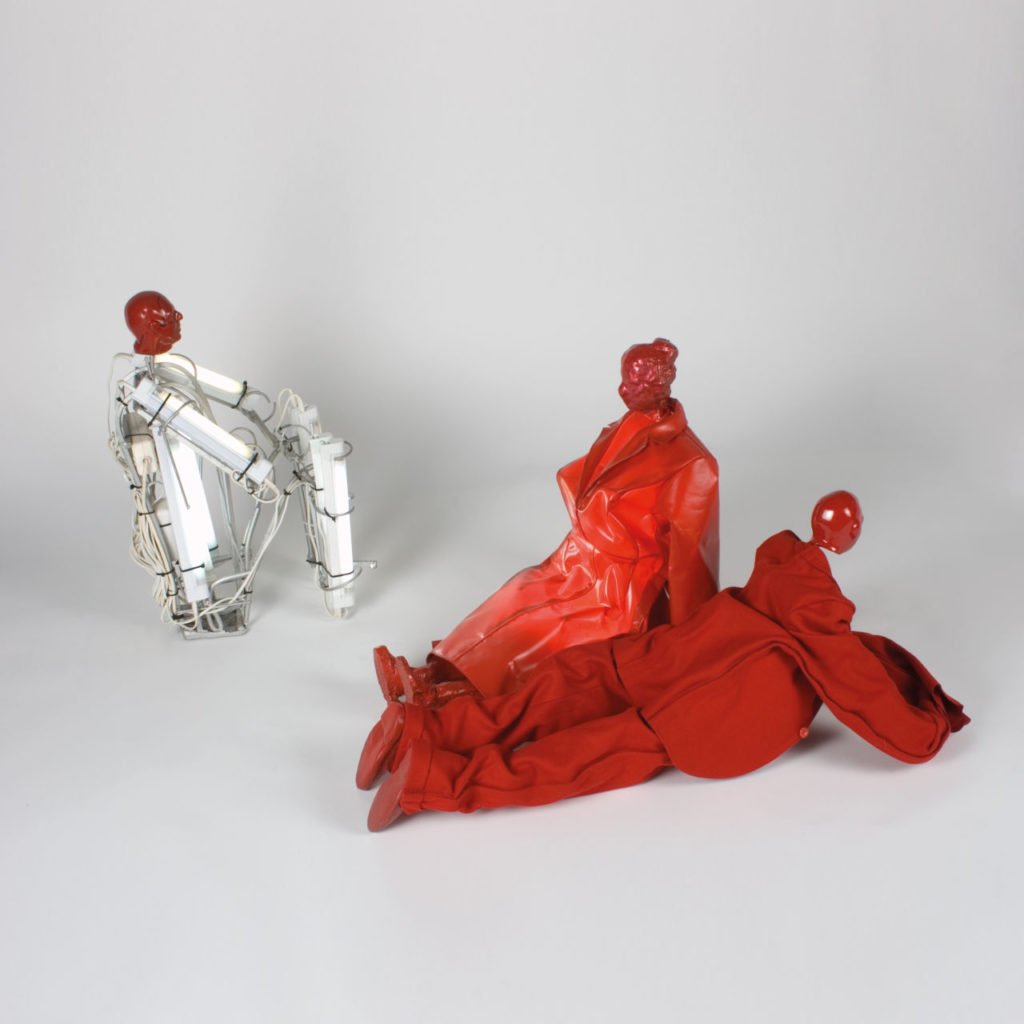
Χιλιάδες φιγούρες συγκεντρωμένες, το 2013 στον εργαστήριο στον Περισσό. Ο Γιώργος, συνεπαρμένος με εκείνο το «σάλο» και το «βουητό» (οι μυστικοί ήχοι από το κέντρο της Αφρικής που, επιστρέφουν μέσω Αμερικής προς την Ευρώπη) που πάνω από την υδάτινη τάφρο ξεχωρίζουν την έκσταση από την καθημερινή εμπειρία και την συλλογική μνήμη από την προσωπική εμπειρία, ετοιμάζεται να στήσει στην Θεσσαλονίκη ένα ισχυρό πολιτικό έργο. Και εδώ, οδηγός πλεύσης θα είναι ο στρατηγός Μακρυγιάννης όπως σχεδίαζε τους στρατιώτες του στο πεδίο της μάχης. Σύνθεση πλήθους σαν να είναι ένα σώμα. Το έργο, βλέπεται, διαθέτει τη μνήμη και τον τρόμο των 9.000 Ελλήνων-Εβραίων της Θεσσαλονίκης συγκεντρωμένων από τους Ναζί το 1942 στην πλατεία Ελευθερίας. Είναι η εγκατάσταση «Ντοκουμέντα και Γλυπτικά Τοπία» που έδειξε στο Εβραϊκό Μουσείο της Θεσσαλονίκης, το 2013, ένα έργο στο οποίο μετέχει η εμπειρία του, από τις σπουδές του στην κλινική ψυχολογία στο κολλέγιο Reed και η συμμετοχή του σε σκληρά ψυχολογικά πειράματα, στο Σαν Φρανσίσκο, το Σαν Ντιέγκο, το Όρεγκον, στην διάρκεια των σπουδών του, στο τέλος της δεκαετίας 1960 και έως τις αρχές της δεκαετίας 1970. Το ενδιαφέρον του για την ψυχιατρική, κατείχε μια μόνιμη εμπλοκή με την δουλειά του. Στο μεγαλειώδες έργο του 2013, μετέχει η μελέτη του στο πείραμα Stanley Milgram, πάνω στο ζήτημα της υπακοής στην εξουσία. Μια καταστρεπτική υπακοή η οποία εξαρτιόταν λιγότερο από την δύναμη της προσωπικότητας και περισσότερο από τις συνθήκες που διαμορφώνονται κάθε φορά, από την πίεση που ασκείται ώστε ένα λογικό ον να εγκαταλείψει κάθε ηθικό φραγμό και κατόπιν εντολής να διαπράξει θηριωδίες.
Η ψυχολογία παραμένει ένα ισχυρό ζήτημα στη δουλειά του Γιώργου Λάππα, το ίδιο ισχυρό και, συχνά συγκλίνων με ζητήματα που φτάνουν από την αρχαία τραγωδία, την κάθαρση ή την κατάλυση της ψυχής. Στην συγκεκριμένη περίπτωση, το έργο του Λάππα φέρει τον Σοφοκλή αλλά και την Hannah Arendt ή την Lauven Stater και μαζί τους, τον Juan de Valdes Leal και το έργο του 1670 in ictu oculi (εν ριπή οφθαλμού). Και βέβαια, ο καλλιτέχνης δεν έχει την παραμικρή σχέση με το μπαρόκ, έχει όμως μια ισχυρή συγγένεια με το νόημα των εικόνων της ιστορίας της τέχνης. Το απόσταγμα που φτάνει πέραν της ζωγραφικής, πέραν των ορατών και απτών στοιχείων, με απώτερο στόχο, το καθαρά οντολογικό ζήτημα του ανθρώπου.
Ο Γιώργος Λάππας, πολυσχιδής προσωπικότητα, αντλεί γνώση και παράγει γνώση. Τον ενδιαφέρει εξίσου, η ιστορία της τέχνης με την φιλοσοφία, την ποίηση, το δημοτικό τραγούδι, το ρεμπέτικο, η συμπεριφορά των πτηνών, τον τρόπο που ένας σκύλος μπορεί να αναγνωρίζει τον καθαρό καλλιτέχνη, όλα τα αρχεία της γνώσης αλλά και των αισθήσεων και παραισθήσεων, χάριν εκείνου του ποσοστού σουρεαλισμού που διαθέτει τόσο στην δουλειά όσο και στην ιδιοσυγκρασία.
Όταν δουλεύει το έργο «Μαντεία με Συκώτι» και το αφήνει στη θάλασσα 40 ημέρες για να το απλώσει μετά στο κτήμα Παυλίδη κάτω από τα δένδρα, όταν πηγαίνει βόλτα το με φορτηγό τα χαράματα, την μηχανή toy «Εlbo» όταν κάνει τις μαντεψιές με τα Ζάρια, ανταλλάσσει φαντασιώσεις με τον θεατή του, στην αποκρυπτογράφηση του κόσμου.
Ανάμεσα στις δύο ενότητες των έργων «Mappemonde» και Ντοκουμέντα που, ορίζουν την αφετηρία της δουλειάς και την ωριμότητα, αντίστοιχα, μεσολαβούν οι εμπνευσμένες στιγμές γύρω από τις μεγάλες κόκκινες φιγούρες που είδαμε αρχικά το 1991 στην γκαλερί Bernier στην Αθήνα, και στο Martin Gropius Bau στο Βερολίνο και στην συνέχεια ταξίδεψαν σ΄ ολόκληρο τον κόσμο σε διεθνείς εκθέσεις και μουσεία. Εδώ ο καλλιτέχνης εισάγει τρία νέα στοιχεία στη δουλειά του. Το κόκκινο χρώμα, το εκμαγείο του σε φυσικό μέγεθος και επανάληψη και το σιδερένιο μηχανισμό που καθορίζει την κίνηση της φιγούρας. Αλλά αυτά είναι τα χαρακτηριστικά τα οποία σκιαγραφούν ένα καλλιτέχνη. Η εμμονή του Γιώργου Λάππα, είναι να ψάξει τον ορισμένο τρόπο που θα συνδέει τα χαρακτηριστικά και την μαστοριά του υλικού με εκείνη της ψυχής. « Από τότε που η λέξη ψυχή εξαλείφτηκε από τη φιλοσοφία, έγινε ταμπού για την τέχνη. Εμένα όμως με ενδιαφέρει» (λόγια του ίδιου).
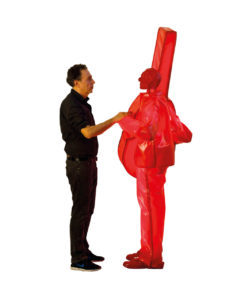
Οι «Κόκκινοι Αστοί», οι αναφορές σε ιστορικές-οριακές στιγμές του παρελθόντος, από τους Αστούς του Καλαί και τον Rodin στον Λαοκόοντα, τον Pierro della Francesca, τον Seurat, τον Van Gogh, έργα, ποίηση, θρησκείες και μουσική απασχολούν το έργο του καλλιτέχνη που, ενεργοποιεί με τη δουλειά και την έρευνα, ζητήματα που άπτονται του ενεργητικού θεατή αλλά και του ενεργητικού καλλιτέχνη που, επαναπροσδιορίζει τη σχέση του με την ιστορία, την ψυχανάλυση, της καταβολές του, τη θέση του απέναντι στο πολιτισμό του σύμπαντος που περιέχει τον κόσμο που βλέπουμε και τον κόσμο που αγνοούμε.
Σ΄ αυτά τα έργα, οι φιγούρες και τα ανθρώπινα μέλη, ακολουθούν την αρχή ότι, ένας άνθρωπος μπορεί να κινείται έξω από κάθε αντικείμενο και για να εισχωρήσει σ’ αυτό πρέπει να το σπάσει. Το σπάσιμο της φιγούρας-αντικείμενο, ο καθρέφτης και η στάση contraposto, όπου το κεφάλι και οι ώμοι έχουν διαφορετική κατεύθυνση από τη λεκάνη και τα πόδια, υποστηρίζει, εκτός των άλλων, την άποψη ότι ο άνθρωπος μπορεί να υπάρχει σε πολλές και διαφορετικές θέσεις. Είναι ένας διάλογος της κάθε φιγούρας με εκείνη που υπάρχει δίπλα της. Η θέση της καθεμιάς εξαρτάται από τη θέση της διπλανής της καθώς και από την σκιά που οροθετείται κάθε φορά. Στην προετοιμασία του έργου του για τους Αστούς και βλέποντας κανείς τις φιγούρες σε κίνηση και δίχως όλα τους τα ρούχα, θυμάται το θέατρο σκιών που τόσο είχε συγκινήσει τον Λάππα στα παιδικά του χρόνια.
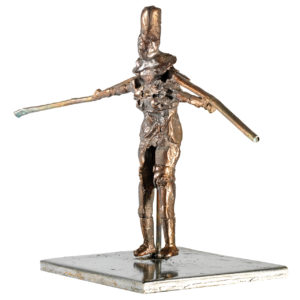
Βλέποντας αυτόν τον τεράστιο όγκο δουλειάς και τις συνεχείς ανατροπές, ανατρέχουμε σε εκείνη τη ρήση του Degas «Περνώ τη ζωή μου κάνοντας δοκιμές».
«Ο άνθρωπος είναι σημαντικός στη γλυπτική, αλλά εξ’ ίσου σημαντικός είναι και ο αχινός ή το κουκουνάρι. Χρυσές τομές δεν υπάρχουν μόνο στον άνθρωπο αλλά και στην αγκινάρα. Να μελετάμε τις φόρμες λοιπόν και όχι σώνει και καλά την κάτοψη.» Τα λόγια του Γ.Λ. ισχυροποιούν την δυναμική της φόρμας όπως την ερευνά στα ζώα και σε ποικίλες μορφές στις οποίες ο ίδιος δίνει χαρακτηρισμούς-ονομασίες, όπως κηπουροί, υπνωτιστές, μάγειροι, μάντεις, τραυματιοφορείς, φαντάσματα στο ατέρμονο κοσμογονικό του σύμπαν.
Oι τίτλοι των έργων, συνθέτουν ένα μεγάλο υλικό από ευρήματα, τόσο ευφυή και άμεσα ώστε να τονίζουν τον ήδη σχολιαστικό και ενίοτε σουρεαλιστικό χαρακτήρα των έργων.
Μία εγκατάσταση του Γ.Λ. πέρα από την οξύτητα της διαδικασίας ενός ατέρμονου τελετουργικού σε κίνηση, ένα πίσω-μπρός στην μνήμη, την ιστορία και τον παρόντα χρόνο, δύναται να δημιουργεί μία «αφήγηση» παράδοξων αποσπασμάτων που, διαθέτουν ενιαίο εννοιολογικό σώμα για τον ανοιχτό θεατή. Πρόκειται για ένα είδος εποποιίας, όπου οι μύθοι, στέκονται κριτικά απέναντι στην ίδια τους την παρουσία, αναπνέουν στην κινητικότητα του χρόνου και επιζητούν την ίδια στιγμή, να συμβιώσουν με την αιωνιότητα.
Από εδώ έως την αιωνιότητα λοιπόν. Από ένα εργαστήριο προς τον μεγάλο κόσμο και τον ακόμη μεγαλύτερο, ως αρμόζει στη δουλειά αυτού του ευγενούς.
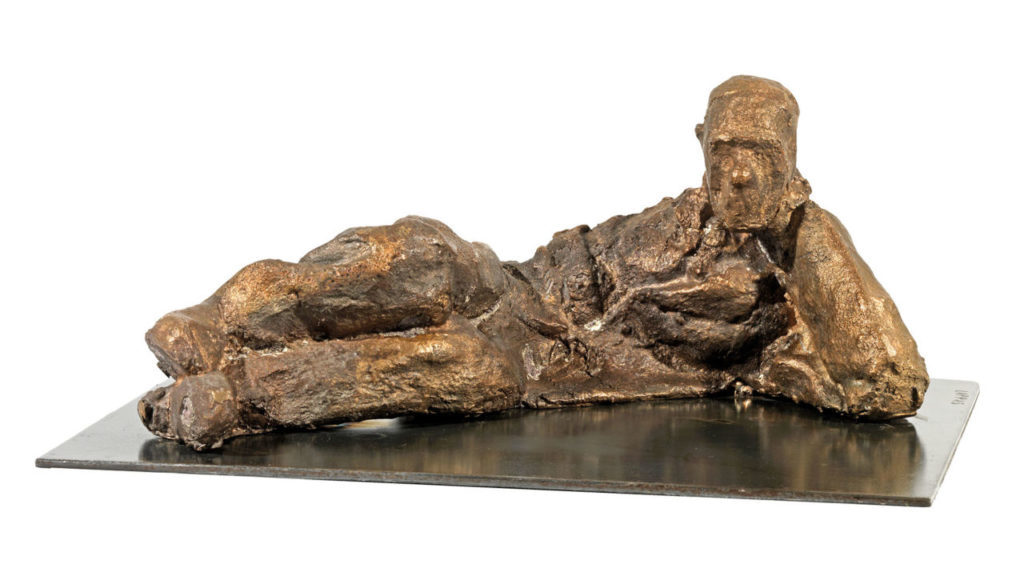
Υ.Σ. Ο τίτλος είναι δάνειο από το βιβλίο του αμερικανού συγγραφέα James Jones (1951) και της ομώνυμης ταινίας του Fred Zinnermann (1953). Θα μπορούσε να χρησιμοποιηθεί μόνο για τον Γιώργο Λάππα.
Μαρία Μαραγκού
Ιστορικός και Kριτικός Tέχνης, Καλλιτεχνική Διευθύντρια
του Μουσείου Σύγχρονης Τέχνης Κρήτης
Ο Δήμαρχος Χανίων
Είναι ιδιαίτερη η χαρά που έχουμε ως Δήμος να φιλοξενούμε στην Πινακοθήκη μας την ξεχωριστή και ευρηματική καλλιτεχνική προσωπικότητα του γλύπτη Γιώργου Λάππα. Ο Αιγυπτιώτης δημιουργός, αν και μακριά μας πια, δίνει ένα δυναμικό «παρών» μέσω του πολυσχιδούς έργου του. Φιγούρες εύπλαστες, παρ’ ότι σμιλευμένες σε άκαμπτα υλικά, ξεπηδούν επιβλητικά και αφηγούνται τις δικές τους ιστορίες, αλλά ταυτόχρονα ιστορίες μέσα από τη ζωή του καλλιτέχνη.
Άλλοτε λιλιπούτειες, άλλοτε θεόρατες, οι μορφές του Γιώργου Λάππα χαρακτηρίζονται από ένα οξύμωρο σχήμα, αυτό της αεικίνητης ακινησίας. ο κόκκινος επιβλητικός άνθρωπος με τη βαλίτσα είναι έτοιμος να ξεκινήσει το ταξίδι του ή μόλις έφτασε για να εγκατασταθεί μόνιμα; Ίσως και μια αναφορά στις διαρκείς μετακινήσεις στη ζωή τού ίδιου του γλύπτη. Ένα παιχνίδι τάσεων ξεπροβάλλει σε κάθε μορφή δίνοντας μια δραματική διάσταση στο έργο του, μαζί με την αλληγορία ή και καμιά φορά την ειρωνεία.
Αυτά και πολλά άλλα στοιχεία, που αναλύονται και παρουσιάζονται στη σημαντική έκδοση που κρατάτε στα χέρια σας, καθιστούν την έκθεση «Από εδώ έως την Αιωνιότητα» ιδιαιτέρως αξιόλογη. Είναι μία πολιτιστική δράση για την οποία ο Δήμος Χανίων καμαρώνει που έχει την τιμή να τη φιλοξενεί εν μέσω της υψηλής επισκεψιμότητας της καλοκαιρινής περιόδου. Εύχομαι από καρδιάς να την απολαύσετε!
Αναστάσιος Βάμβουκας
Δήμαρχος Χανίων
Ο Πρόεδρος της Δημοτικής Πινακοθήκης Χανίων
Από τις απαρχές του ανθρώπινου πολιτισμού, η γλυπτική και η μηνυματική που εκπέμπει, υπήρξε η τέχνη εκείνη που συνόδευσε με συνέπεια τον ανθρώπινο πολιτισμό σε όλα του τα στάδια μέχρι τις μέρες μας. Στη διάρκεια των αιώνων, οι αρχές της γλυπτικής γνώρισαν μεταβολές, που αφορούσαν τις αφετηρίες της έκφρασης. Ενδεικτικά, η βασική αρχή που έφερε την μετάβαση εκείνη από το στάδιο της αρχαϊκής γλυπτικής (6ος αιώνας π.χ.) στην κλασσική ήταν ότι η αρμονική σύνθεση των μερών δεν πρέπει να ακολουθεί άκαμπτους νόμους, αλλά μπορούσε να μεταβάλλεται ανάλογα με την βαθύτερη έννοια του έργου και την αντίστοιχη οπτική εικόνα, που ο καλλιτέχνης ήθελε να μεταδώσει στον θεατή-αποδέκτη.
Αρχή -ανάλογα και αντιστικτικά- δοσμένη είναι, κατά τη γνώμη μου, αυτό που απορρέει από το συγκλονιστικό έργο του Γιώργου Λάππα, ενός ιδιοφυούς δασκάλου, όπου -σαν φυσική παρουσία μόνο- δεν βρίσκεται πλέον μαζί μας. Ένας Αιγυπτιώτης Έλληνας με διεθνή αναγνώριση, ένας δια βίου πολίτης του κόσμου (Αίγυπτος, Η.Π.Α., Ινδίες, Αγγλία, Γαλλία, Ελλάδα), με ένα έργο που έχει ως αρχή και κύριο «εργαλείο» την υπέρβαση των εκάστοτε ορίων.
«Με απασχολούσε η εικόνα της ανθρωπότητας, ποτέ η εικόνα του ανθρώπου»
«Το αληθινό ταλέντο του καλού γλύπτη είναι η ικανότητα να κουμαντάρει το ψυχικό υλικό του ιλίγγου»
Λόγια δικά του, που γίνονται παρακαταθήκη, συνοδεύοντας το μεγάλο του έργο, αλλά και ίσως νέων καινοτόμων βασικών αρχών, για το αύριο της γλυπτικής.
Γιώργος Βαρουδάκης
Πρόεδρος Δ.Π.Χ.
- Η έκθεση είναι κατάλληλη για τα παιδιά και η τιμή εισόδου είναι 2 € το ολόκληρο εισιτήριο, 1 € το μειωμένο και δωρεάν για τους επισκέπτες κάτω των 18 χρονών και άνω των 60..
- Ωράριο λειτουργίας: Δευτέρα έως Σάββατο, 10.00 – 14.00 και 19.00 – 22.00